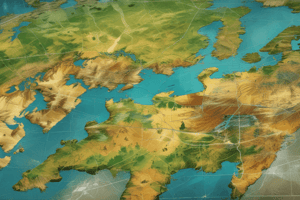Podcast
Questions and Answers
What is the primary consideration when selecting an incident angle for flood monitoring applications?
What is the primary consideration when selecting an incident angle for flood monitoring applications?
- Small incident angle to increase contrast between land and water (correct)
- Large incident angle to minimize shadows
- Incident angle is not a critical factor in flood monitoring
- Medium incident angle to balance land and water contrast
What is the primary consideration when selecting a data acquisition strategy for geological mapping applications?
What is the primary consideration when selecting a data acquisition strategy for geological mapping applications?
- Topography and surface cover are the primary considerations
- Time of acquisition is critical
- Incident angle is the most important factor
- Size of the area and target of interest are key factors (correct)
When is the timing of image acquisition a priority?
When is the timing of image acquisition a priority?
- During geological mapping applications
- During flood monitoring applications (correct)
- During environmental condition monitoring
- During none of the above
What is the purpose of acquiring images before, during, and after a flood event?
What is the purpose of acquiring images before, during, and after a flood event?
Study Notes
Selecting a RADAR Image
- To select a RADAR image, users need to be "Radar-Smart" and "Geo-smart", considering the sensor's characteristics and environmental criteria.
- For Spaceborne Microwave Sensors, the most important criteria is the geo-smart criteria, including area, topography, land use, and land cover, and season.
Sensor Characteristics
- RADARSAT has multiple characteristics, including swath width, ground resolution, incident angle, orbit, and look direction.
- Users can tailor the acquisition of RADARSAT data based on various criteria, such as:
- Area of coverage and resolution
- Viewing geometry or incident angle
- Look direction of the sensor
- Acquisition time (dusk or dawn)
- Levels of detail (pixel size)
- Positional accuracy with respect to a defined map projection
- Turnaround time from data acquisition to delivery
- Acquisition strategy (single/multiple data acquisition)
- Land use/land cover and topography
The Ordering Process
- The ordering process involves several steps, including:
- Planning (at least 4 weeks before acquisition)
- Ordering (at least 2 weeks before acquisition date)
- Satellite programming
- Image acquisition
- Processing
- Delivery
Applications
- Applications involving dynamic phenomena (e.g., flood monitoring) require near-real-time delivery of images and consideration of factors such as:
- Topography
- Basin morphology
- Flow of water
- River width
- Flood duration
- Broad cover types
- Environmental conditions
- Applications that do not involve dynamic factors (e.g., geological mapping) require consideration of factors such as:
- Size of area
- Size of target of interest (resolution)
- Topography (range of elevation, aspect, and slope inclination)
- Preferential lineament orientation (look direction)
- Surface cover (vegetated/bare)
- Time of acquisition (year, season, and day)
Studying That Suits You
Use AI to generate personalized quizzes and flashcards to suit your learning preferences.
Related Documents
Description
Test your knowledge on selecting the right RADAR image for specific applications by considering the sensor characteristics and environmental criteria. This quiz covers the key factors to be considered when choosing a RADAR image, including the importance of being 'Radar-Smart' and 'Geo-Smart'.




